Innovation and Sustainable Solutions for Mobility in Rural Areas: A Comparative Analysis of Case Studies in Europe
Abstract
1. Introduction
2. Materials and Methods
- Cycling Without Age in Kalundborg and Lamvig, Denmark (Mobility Mode): this initiative aims to connect older people with society through voluntary rides.
- Transport on demand and shared mobility in Badenoch and Strathspey (Mobility Mode): this service addresses the needs of rural populations, particularly older people, by providing accessible transport, including vehicles for people with disabilities.
- Conversion of old rail trails into greenways in Ireland (Mobility Infrastructure): abandoned rail trails are converted into cycling paths, enhancing connectivity and preserving cultural heritage, similar to the renewed side railway in the Marche Region, from Fabriano to Pergola, that we have experienced during an international workshop.
- Service-to-People accessibility solution in Hallig Hooge (Mobility Platform): this initiative shifts the traditional mobility paradigm by bringing services directly to the doorstep of the isolated islanders of Hallig Hooge, many of whom are elderly.
| Categories | Good Practice Name | EU Country | Activation |
|---|---|---|---|
| Mobility modes |
| Scotland | 2017–2020 |
| Denmark | 2012 | |
| Austria | 2017–2020 | |
| Latvia | 2017–2020 | |
| Scotland | 2018 | |
| Germany | 2018 | |
| Ireland | 2001 | |
| Germany | 2013 | |
| Germany | 2019 | |
| Italy | 2022 | |
| Mobility infrastructure |
| Italy | 2014 |
| Ireland | 2019 | |
| Ireland | 2021 | |
| Spain | 2017-2018 | |
| Poland | 2019-2021 | |
| Belgium | 2016 | |
| Scotland | 2021 | |
| Mobility platforms |
| Portugal | 2013 |
| France | 2009 | |
| Scotland | 2018 | |
| Italy | 2019 | |
| Finland | 2019 | |
| Denmark | 2019 | |
| Germany | 2018 |
3. Analysis and Results
3.1. Contextual Overview
3.1.1. Mobility Modes
3.1.2. Mobility Infrastructure
3.1.3. Mobility Platforms
3.2. Analysis of the Selected Practices
3.2.1. Good Practice #1: Cycling Without Age in Kalundborg and Lamvig, Denmark (Mobility Mode: Micromobility)
Description of the Context
Description of the Practice
Issues and Critical Elements
- Social Isolation: Many older people experience social isolation, especially those who reside in nursing facilities or have limited mobility. Their inability to move about or access transportation prevents them from participating in social activities that allow them to meet new people and learn about their communities.
- Loss of Independence: As people age, they often become less independent, especially in terms of mobility. Many older people are less able to engage in outdoor activities and socialize with others because they are unable to walk or pedal long distances.
- Physical and Mental Health: Exercise and exposure to fresh air are critical for the general well-being of older adults. An older person’s mental and cognitive health might suffer from spending too much time indoors, and many of them have little access to outdoor spaces or activities that promote health.
- Generational Connection: Enhancing intergenerational relationships was another goal of the program. By recruiting volunteers, often younger people, to go on bike rides with the elderly, “Cycling Without Age” fosters intergenerational relationships and provides younger people with the chance to engage with them in meaningful ways.
Main Elements
- Restoring Mobility and Freedom: Older people who might no longer be able to ride motorcycles because of mobility issues can now experience the freedom that comes with riding a rickshaw. Their sense of independence and connection to nature are restored by this small gesture.
- Intergenerational Bonding: The program helps senior passengers and volunteer cyclists (pilots) develop deep connections. In addition to providing transportation, these rides promote memory sharing, storytelling, and intergenerational trust, all of which improve the emotional and mental health of senior citizens.
- Scaling through Volunteerism: The concept’s rapid and natural growth through word of mouth demonstrates the power of community-based innovation. Beginning with a small group of volunteers, the project swiftly expanded throughout Denmark and abroad as more people were motivated to join.
- Combating Ageism: By actively involving senior citizens in an activity typically associated with youth and physical fitness, the pilot combats societal ageism and advances the notion that one’s age should not determine one’s capacity to enjoy life and maintain an active lifestyle.
Innovations in This Good Practice
- Engagement and Partnership: The foundation of Cycling Without Age is volunteerism, which allows local communities worldwide to participate in providing free trishaw rides to senior persons. By recruiting local volunteers, the program combats senior isolation and fosters social contacts. This community-driven approach not only enhances well-being but also strengthens intergenerational bonds and creates a more welcome and supportive environment in the communities it serves.
- Social Inclusivity: It prevents social isolation, bridges generational divides, and ensures that older people may engage in communal life. It improves seniors’ quality of life by allowing them to engage with their environment and enjoy the outdoors. Apart from this, the locations of Kalundborg and Lemvig are presented in Figure 4.
Worldwide Expansion
3.2.2. Good Practice #2: Transport on Demand and Shared Mobility in Badenoch and Strathspey (Mobility Mode: On Demand and Shared Mobility)
Description of the Context
Description of the Practice
Issues and Critical Elements
- Limited Access to Public Transportation: Due to Badenoch and Strathspey’s low population density, regular service operations are financially untenable for transport operators. Many residents are unable to use public transportation for essentials because of the limited routes and erratic mobility due to the small population.
- Insufficient Assistance for Seniors and Residents with Limited Mobility: Many times, older or less mobile persons cannot use the public transportation options that are now available. Buses may lack accessibility features like wheelchair spaces or low floors, which makes it difficult for these individuals to travel on their own, particularly in more remote areas.
- Limited Door-to-Door Transportation Options: For those who are unable to utilize conventional public transportation, there are not many door-to-door transportation options. The capacity and availability of the already available community transport options are sometimes limited, and many residents, especially the elderly and disabled, find it challenging to travel to bus or rail stops. As a result, residents become isolated and are unable to access essential services.
Essential Elements
- Social Inclusion: to improve the social inclusion of senior citizens and others with mobility impairments by offering reasonably priced and easily accessible modes of transportation, guaranteeing their access to daily necessities, social activities, and healthcare.
- Sustainability: to create a long-term, community-driven transportation strategy that relies on volunteer assistance and local collaborations to sustain operations and grow services.
- Community Cohesion: to promote social interaction, engagement in activities, and better access to community life by providing transportation options that lessen isolation and strengthen links within the community.
- Improved Mobility: to solve rural areas’ mobility issues by providing adaptable, affordable, and easily accessible transportation options, particularly in places with few or no public transportation options.
Innovation in This Good Practice
- Engagement and Partnership: The program encourages cooperation between regional parks, local government agencies, tourism offices, and community businesses, promoting alliances for sustainable, locally driven solutions. The Community Transport Association (CTA), a UK charity that assists neighborhood organizations in providing necessary transportation services, founded the service. Its main goal is to increase everyone’s access to transportation.
- Social Inclusivity: The program’s major goal is to transport the elderly and disabled, who are frequently left out of the mainstream transportation system. Those who have trouble climbing stairs can easily reach their vehicles thanks to lifts or ramps. Skilled drivers provide passengers with individualized door-to-door assistance.
Key Features and How the Section 22 Permit/Service Works
- Operated by Not-for-Profit Organizations: Section 22 services are operated by community transport organizations or other non-profit entities, meaning that the focus is on service provision rather than making a profit.
- Public Service: since Section 22 services are available to the entire public, they are inclusive and generally accessible in contrast to many other community transportation programs that are restricted to particular demographics (such as the elderly or the disabled).
- Volunteers: Fully trained volunteer drivers who may possess specialized licenses to handle larger vehicles are frequently used to operate the bus services. This volunteer expectation promotes community involvement while keeping expenses down.
- Localized and Adaptable Routes: Section 22 services are intended to fill in the gaps in public transportation. They usually work in places like rural or underserved communities where traditional bus companies do not provide enough services. Buses can frequently be reserved in advance for door-to-door services, and the routes and schedules are adjusted to meet the demands of the community.
- Vehicle Accessibility: to ensure that even individuals with mobility impairments may utilize the service, these services frequently make use of cars that are accessible to individuals with disabilities, such as minibuses equipped with wheelchair lifts.
- Fare Collection: although fares may be assessed for passengers, they are typically subsidized and reasonably priced because the service’s objective is to serve the community’s needs rather than make a profit.
- Funding and Licensing: in order to legally run the bus service, Section 22 services must register with the Traffic Commissioner and ask for funding from local authorities.
- Service Type: It is a public local bus service run by non-profit organizations or community transport groups in contrast to commercial bus services. These services are especially intended to cover gaps in public transportation in places like rural or remote areas where commercial operators do not offer enough services.
- Operators: Non-profit groups, such community transportation companies or charities, are in charge of operating Section 22 services. These groups submit an application for a Section 22 permit, which enables them to operate the service lawfully and collect fees.
- Government Role: Community organizations must apply for licenses under Section 22 and the legal framework provided by the UK government (via the Traffic Commissioner). Although community organizations, not the government, provide the services directly, the government may also offer grants or subsidies through local authorities to assist pay for these activities.
- Volunteer Involvement: A large number of Section 22 services are run by volunteer drivers and are intended to be accessible and reasonably priced to cater to the needs of the community, frequently targeting those who are old, disabled, or otherwise underserved by conventional public transportation.
3.2.3. Good Practice #3: Conversion of Old Rail Trails to Greenways, Ireland (Mobility Infrastructure: Bike Paths and Pedestrian Ways)
Description of the Context
Description of the Practice
Issues and Critical Elements
- Abandonment and Decay of Historical Rail Lines: A number of the region’s old rail lines have been abandoned, leading to overgrowth and ruin. These abandoned rails are now unused resources because so much of the infrastructure is decaying. Reviving these lines could help restore lost transit linkages and enhance regional connectivity.
- Absence of Paths for Safe Bicycling and Walking: Designated bike and walking lanes were desperately needed to encourage better living and environmentally friendly transportation. Because residents and visitors lacked safe paths for bicycling and walking, inadequate infrastructure made it challenging to promote environmentally friendly travel and outdoor activities.
- Economic Revitalization: Reviving these transit networks, which comprised train lines and sidewalks, provided a chance to boost the local economy. By attracting tourists and supporting local small businesses, better transportation infrastructure may stimulate economic growth, create jobs, and make the area a more desirable vacation destination.
Main Elements
- Preservation of Heritage along the Route: The Old Rail Trail incorporates historic features including intact stone arch bridges and rebuilt railway station structures (such as Moate and Castletown Stations). These historic buildings enhance the cultural experience by acting as educational stops in addition to adding elegance.
- Uisneach Historical Site: by linking nature and history, the trail leads to the Hill of Uisneach, a significant archeological and mythological site that enhances tourists’ experiences.
- Diverse Access Points: From Athlone to Mullingar, the route has a number of access points. Important places like Castletown Station, Newbrook, and Tully offer free parking. This makes it more accessible and adaptable for a variety of user groups (families, visitors, and locals) by enabling users to start or finish their journey at multiple locations.
- Connection with Other Greenways: The Old Rail Trail has a direct connection to the Royal Canal Greenway, which extends the trail network by connecting to places like Longford and Dublin. Longer distances for ecotourism and multi-day excursions are encouraged by this cross-connectivity.
- Family-Friendly Infrastructure: All ages may enjoy the trail’s level, well-kept routes, and a variety of bikes, including electric and tandem bikes, are available for rent. Both experienced bikers and families with small children can enjoy the trail thanks to its inclusive design.
- Eco-Tourism Support: The trail promotes eco-friendly travel by offering bike hire facilities at several points (Athlone, Moate, and Mullingar). The easy terrain also makes it possible for cyclists to cover the entire 43 km route without needing a car, aligning with sustainable tourism practices.
- Attractions along the Trail: The route is dotted with key attractions like Athlone Castle, Dún na Sí Amenity & Heritage Park, and the Hill of Uisneach. This makes the trail not just a cycling route but also a cultural and recreational journey, encouraging the exploration of nearby towns and heritage spots.
Innovation in This Good Practice
- Social Inclusivity: The path features “Greenway Hubs”, which are powered by sustainable solar energy and provide drinking water, bike racks, sitting, and shelter. While taking a rest, guests can use smart seats with USB ports to charge their gadgets. By incorporating accessibility features, the path is made inclusive and friendly for people of all abilities, improving sustainability and convenience for all visitors.
- Community Engagement: By bringing communities together and interacting with them through refurbished historic buildings, the trail promotes social inclusion. The trail’s integration of historical features along its path not only protects cultural heritage but also promotes community engagement, strengthening ties between locals and tourists.
3.2.4. Good Practice #4: The Service-to-People Accessibility Solution in Hallig Hooge (Mobility Platform: Service-to-People Accessibility Platform)
Description of the Context
Description of the Practice
Issues and Critical Elements
- Geographic Isolation: Hallig Hooge is a small island in the North Sea that is difficult to get to and frequently floods. Residents have to take a 1.5 h ferry to reach the mainland, which significantly limits their access to essential services and makes daily life challenging, especially during bad weather.
- Lack of Public Transport: People cannot use public transportation, and there are not many cars on the island. Because of this, a lot of people have trouble getting around, particularly those who cannot drive, which limits their ability to travel for work, shopping, or medical appointments.
- Aging Population: A significant portion of the island’s population is old, and they frequently require access to social services and medical care. However, due to the island’s remote position, it might be challenging and time-consuming to go to the mainland for services like doctor’s appointments.
- Digital Divide: Many senior citizens on Hallig Hooge have limited access to online services due to their incapacity to use digital technologies. They have a harder time accessing social media, healthcare, and online government services because of the digital divide.
Main Elements
Innovation in This Good Practice
- Community involvement: The people of Hallig Hooge actively contributed to the project’s development. A “solution tree” and frequent meetings gave locals a way to express their priorities and participate in decision making. By ensuring that services like mobile counseling and healthcare were customized to the unique needs of the island, this strategy helped to build a strong sense of trust and ownership among the residents.
- Social Inclusivity: Through in-person meetings and telemedicine, vital social services like healthcare and counseling are provided directly to isolated residents on Hallig Hooge, especially helping the elderly. By providing assistance to vulnerable people, this strategy promotes social innovation and increases inclusivity.
How the Idea Was Developed
- Identifying the Need: The small, isolated island of Hallig Hooge has limited access to essential services such as healthcare, social counseling, and elderly care. With no public transport except for a ferry to the mainland, residents, particularly the elderly, face challenges in accessing services. Community meetings, led by Diakonie Schleswig-Holstein and the island’s mayor, revealed that the population wanted to age in place without having to frequently travel to the mainland for services.
- Involving the Community: From the outset, regular meetings were held with the island’s residents at the local hub, “Markttreff.” These meetings allowed the residents to express their needs and concerns, such as the desire for local elderly care training and social counseling. A “solution tree” was created to visualize the issues faced by the residents and identify priorities. This inclusive approach ensured that the solution directly addressed the community’s specific needs.
- Mobile Social Counseling: Diakonie developed a mobile social counseling service that brought professional counselors to the island to offer face-to-face consultations on-site. This ensured that islanders could access crucial services without needing to travel. Special attention was given to elderly residents, with courses offered on-site to help community members learn how to care for their aging neighbors, promoting self-sufficiency in elderly care.
- Introduction of Video Conferencing: Recognizing the limitations of on-site services due to geographical isolation, the project introduced video conferencing technology to connect islanders with healthcare and social service professionals based on the mainland. This technology allowed for remote consultations, including discussions with doctors, social workers, and specialists. For example, a video conference with a dementia specialist was organized to provide residents with knowledge and training on how to support elderly individuals with dementia. Despite the older population’s initial unfamiliarity with digital tools, the project ensured that the video conferencing was easy to use, and early trials of digital consultations were met with success, with a high-quality digital transmission.
- Combining Digital and Face-to-Face Services: The project combined on-site services (such as elderly care training and social counseling) with remote digital services (via video conferencing), creating a hybrid model that allowed the community to access a wide range of services without the need for frequent travel to the mainland. This dual approach balanced the community’s preference for face-to-face interaction while also leveraging technology to overcome geographical barriers.
- Expanding the Scope: The success of this hybrid model encouraged plans to expand the video conferencing system further, with upcoming online courses planned for dementia care and other health-related issues. The long-term goal was to continue providing services to vulnerable groups on the island, including the elderly, people with disabilities, and families in crisis, ensuring ongoing accessibility to essential services through both digital and in-person means.
- Ensuring Sustainability: Regular meetings with the islanders and collaboration with the Diakonie’s In-House Mobility Centre ensured that the solution remained responsive to the community’s needs and evolved over time. The project also emphasized the importance of community trust by involving the islanders in every step of the planning and execution process.
3.3. Synthetical Overview and Comparative Analysis of the Four Selected Practices
| Name of Good Practices | Land Area Sq.km | Total Population | Population Dynamics | Population Density pr sq km | |||
|---|---|---|---|---|---|---|---|
| 0–19 Years (2022) | 20–64 Years | 65 Year and Above (2022) | |||||
| 2011 | 2024 | ||||||
| 16.76/4.95 | 23,575 | 23,360 | 4603 | 12,128 | 4371 | 988.1/1373 | |
| 2331 | 13,680 | 12,782 (2022) | 2319 | 7003 | 3456 | 5.484 |
| 32.57 | 43,262 | 48,846 (2022) | 12,547 | 28,956 | 6533 | Avg (1414.57) |
| 5.78 | 109 | 101 (2022) | 19 | 54 | 28 | 17.30 |
4. Discussion and Conclusions: Comparative Analysis of the Four Selected Practices
4.1. Discussion
4.1.1. Similarities
- Social Inclusion: Improving disadvantaged groups’ access to transport, particularly for the elderly and those with limited mobility, is a top priority for all four programs. By making sure that these groups may actively engage in communal life, which is essential for their well-being, they want to lessen social isolation.
- Volunteer Involvement: The community is essential to the functioning of these services in each instance. The maintenance of these programs depends on volunteer drivers in Badenoch and Strathspey and Cycling Without Age in Denmark. This strategy promotes a feeling of belonging and control over transportation options.
- Community Engagement: The community is involved in the design and decision-making processes of every endeavor. To guarantee that services represent local needs and preferences, for example, Hallig Hooge and Cycling Without Age both rely on participatory planning, which increases uptake and sustainability.
4.1.2. Differences
- Geographic context
- o
- Cycling Without Age is able to promote intergenerational contacts between the elderly and younger workers in Kalundborg, Denmark, an industrial town with a younger workforce and comparatively superior infrastructure. Lemvig, on the other hand, is a smaller, more isolated seaside town that places a greater emphasis on social sustainability and renewable energy, which makes it the perfect place for intergenerational interaction in a more intimate community.
- o
- It is difficult for traditional public transport to operate in Badenoch and Strathspey since it is a rural area with a very low population density (5.4 persons per square kilometer) and hard weather, including harsh winters. Because they offer door-to-door services in a demand-responsive paradigm, community transport services are crucial in this situation because they address both environmental harshness and geographic isolation.
- o
- Westmeath, which is distinguished by its blend of urban and rural areas, uses the Old Rail Trail to link towns with a greenway, offering a car-free, environmentally friendly path that is appropriate for all ages and fosters social inclusion. Although the area is easier to reach due to its level topography than the hilly areas of Badenoch and Strathspey, rural connectivity is still a problem.
- o
- The remoteness of Hallig Hooge, an island without direct access to mainland amenities, makes it special. In this situation, the Service-to-People Accessibility Project offers a customized solution by bringing services right to residents’ doorsteps, thereby resolving the severe difficulties of obtaining essential services in a location with few options for transportation.
- Environmental and geographic factors
- o
- Transportation in Badenoch and Strathspey is severely hampered by the region’s rough topography and harsh weather (such as heavy snowfall in the winter), necessitating accessible solutions that can also be adjusted to the demands of the environment.
- o
- Lemvig benefits from its compact rural nature and strong environmental focus, which aligns well with the goals of Cycling Without Age to promote eco-friendly transport and reduce dependency on cars.
- o
- In contrast, Westmeath’s Old Rail Trail is built on relatively level terrain and functions more as an infrastructure revamp to encourage both mobility and tourism. Compared to larger regions where connectivity issues may be more complicated, the town’s modest size makes it easier to integrate such programs.
4.2. Conclusions
Author Contributions
Funding
Institutional Review Board Statement
Informed Consent Statement
Data Availability Statement
Acknowledgments
Conflicts of Interest
References
- Woodhill, J.; Kishore, A.; Njuki, J.; Jones, K.; Hasnain, S. Food systems and rural wellbeing: Challenges and opportunities. Food Secur. 2022, 14, 1099–1121. [Google Scholar] [CrossRef]
- Social Justice for Rural Populations Means Prosperity for the Planet. InfoStories. Available online: https://webapps.ilo.org/infostories/en-GB/Stories/Employment/rural-economies#inequalities (accessed on 1 August 2024).
- Cottrill, C.D.; Brooke, S.; Mulley, C.; Nelson, J.D.; Wright, S. Can multi-modal integration provide enhanced public transport service provision to address the needs of vulnerable populations? Res. Transp. Econ. 2020, 83, 100954. [Google Scholar] [CrossRef]
- Næss, P.; Xue, J.; Stefansdottir, H.; Steffansen, R.; Richardson, T. Second home mobility, climate impacts and travel modes: Can sustainability obstacles be overcome? J. Transp. Geogr. 2019, 79, 102468. [Google Scholar] [CrossRef]
- Rural Mobility: Rural mobility|Rural Pact Community Platform. Available online: https://ruralpact.rural-vision.europa.eu/groups/rural-mobility_en (accessed on 14 August 2024).
- Lorenzini, A.; Ambrosino, G.; Finn, B.; Policy Recommendations for Sustainable Shared Mobility and Public Transport in European Rural Areas. The SMARTA Consortium. 2021. Available online: https://ruralsharedmobility.eu (accessed on 14 August 2024).
- International Transport Forum. Innovation for Better Rural Mobility; ITF Report; Organisation for Economic Co-operation and Development: Paris, France, 2021; Available online: https://www.itf-oecd.org/sites/default/files/docs/innovation-rural-mobility.pdf (accessed on 14 August 2024).
- European Commission. European Rural Mobility Network Meeting: Rural Pact Adds Value in Addressing Rural Mobility. Rural Pact. 2023. Available online: https://ruralpact.rural-vision.europa.eu/news/european-rural-mobility-network-meeting-rural-pact-adds-value-addressing-rural-mobility_en (accessed on 14 August 2024).
- Stjernborg, V.; Svensson, G.L. Rural mobility in later life; counteracting accessibility poverty with digital service solutions. Transp. Res. Part D Transp. Environ. 2024, 126, 104030. [Google Scholar] [CrossRef]
- Shirgaokar, M.; Dobbs, B.; Anderson, L.; Hussey, E. Do rural older adults take fewer trips than their urban counterparts for lack of a ride? J. Transp. Geogr. 2020, 87, 102819. [Google Scholar] [CrossRef]
- Hansen, S.; Newbold, K.B.; Scott, D.M.; Vrkljan, B.; Grenier, A. To drive or not to drive: Driving cessation amongst older adults in rural and small towns in Canada. J. Transp. Geogr. 2020, 86, 102773. [Google Scholar] [CrossRef]
- Mattioli, G. ‘Forced Car Ownership’ in the UK and Germany: Socio-spatial patterns and potential economic stress impacts. Soc. Incl. 2017, 5, 14. [Google Scholar] [CrossRef]
- Curl, A.; Clark, J.; Kearns, A. Household car adoption and financial distress in deprived urban communities: A case of forced car ownership? Transp. Policy 2018, 65, 61–71. [Google Scholar] [CrossRef]
- Lucas, K.; Mattioli, G.; Verlinghieri, E.; Guzman, A. Transport poverty and its adverse social consequences. Proc. Inst. Civil Eng.-Transp. 2016, 169, 353–365. [Google Scholar] [CrossRef]
- Kiss, M. Understanding Transport Poverty; European Union, European Parlimentary Research Service: Maastricht, The Netherlands, 2022; Available online: https://www.europarl.europa.eu/RegData/etudes/ATAG/2022/738181/EPRS_ATA(2022)738181_EN.pdf (accessed on 3 September 2024).
- Region Norrbotten. Regional Utvecklingsstrategi Norrbotten 2030; Region Norrbotten: Boden, Sweden, 2019. [Google Scholar]
- Shergold, I.; Parkhurst, G.; Musselwhite, C. Rural car dependence: An emerging barrier to community activity for older people. Transp. Plan. Technol. 2012, 35, 69–85. [Google Scholar] [CrossRef]
- Stjernborg, V.; Nilsson, D. Kollektivtrafikens Bidrag till Samhällsutveckling; K2 Research; K2-Nationellt Kunskapscentrum for Kollektivtrafik: Lund, Sweden, 2018. [Google Scholar]
- Marsden, G.; Kimble, M.; Nellthorp, J.; Kelly, K. Sustainability assessment: The defnition defcit. Int. J. Sustain. Transp. 2010, 4, 189–211. [Google Scholar] [CrossRef]
- Karjalainen, L.E.; Juhola, S. Urban transportation sustainability assessments: A systematic review of literature. Transp. Rev. 2021, 41, 659–684. [Google Scholar] [CrossRef]
- Holden, E.; Gilpin, G.; Banister, D. Sustainable mobility at thirty. Sustainability 2019, 11, 1965. [Google Scholar] [CrossRef]
- Mounce, R.; Beecroft, M.; Nelson, J.D. On the role of frameworks and smart mobility in addressing the rural mobility problem. Res. Transp. Econ. 2020, 83, 100956. [Google Scholar] [CrossRef]
- Curtis, C.; Perkins, T. Travel behaviour: A review of recent literature. Urbanet 2006, 58. [Google Scholar]
- De Jong, W.; Vogels, J.; van Wijk, K.; Cazemier, O. The key factors for providing successful public transport in low-density areas in the Netherlands. Res. Transp. Bus. Manag. 2011, 2, 65–73. [Google Scholar] [CrossRef]
- Morsche, W.; La Paix Puello, L.; Geurs, K.T. Potential uptake of adaptive transport services: An exploration of service attributes and attitudes. Transp. Policy 2019, 84, 1–11. [Google Scholar] [CrossRef]
- Porru, S.; Misso, F.E.; Pani, F.E.; Repetto, C. Smart mobility and public transport: Opportunities and challenges in rural and urban areas. J. Traffic Transp. Eng. (Engl. Ed.) 2020, 7, 88–97. [Google Scholar] [CrossRef]
- Gronau, W. Encouraging behavioural change towards sustainable tourism: A German approach to free public transport for tourists. J. Sustain. Tour. 2017, 25, 265–275. [Google Scholar] [CrossRef]
- Gutiérrez, A.; Miravet, D. The determinants of tourist use of public transport at the destination. Sustainability 2016, 8, 908. [Google Scholar] [CrossRef]
- Le-Klähn, D.T.; Hall, C.M. Tourist use of public transport at destinations—A review. Curr. Issues Tour. 2015, 18, 785–803. [Google Scholar] [CrossRef]
- Perkumienė, D.; Pranskūnienė, R.; Vienažindienė, M.; Grigienė, J. The right to a clean environment: Considering green logistics and sustainable tourism. Int. J. Environ. Res. Public Health 2020, 17, 3254. [Google Scholar] [CrossRef]
- Müller, D.K. Second homes in rural areas: Refections on a troubled history. Nor. Geogr. Tidsskr.-Nor. J. Geogr. 2011, 65, 137–143. [Google Scholar] [CrossRef]
- Rodrigue, J.-P. Chapter 5—Transportation Modes: The Geography of Transport Systems. In The Geography of Transport Systems; The Spatial Organization of Transportation and Mobility; Routledge: New York, NY, USA, 2023; Available online: https://transportgeography.org/contents/chapter5/ (accessed on 17 June 2024).
- Max Planck Institute for Social Anthropology. Linked and Distributed Mobilities. Available online: https://www.eth.mpg.de/molab-inventory/linked-and-distributed-mobilities (accessed on 17 June 2024).
- Baudry, G.; Macharis, C. Decision-Making for Sustainable Transport and Mobility; Multi-Actor Multi-Criteria Analysis; Edward Elgar Publishing: Cheltenham, UK, 2018. [Google Scholar] [CrossRef]
- Dax, T. Assessing the impact of rural development policies (incl. leader) conceptual background and priorities of European Rural Development Policy, Academia.edu. 2015. Available online: https://www.academia.edu/18418854/Assessing_the_impact_of_rural_development_policies_incl_LEADER_Conceptual_Background_and_Priorities_of_European_Rural_Development_Policy (accessed on 15 January 2025).
- Dax, T.; Fischer, M. An alternative policy approach to rural development in regions facing population decline. Eur. Plan. Stud. 2018, 26, 297–315. [Google Scholar] [CrossRef]
- Copus, A.; Shucksmith, M.; Dax, T.; Meredith, D. Cohesion Policy for rural areas after 2013: A rationale derived from the EDORA project (European Development Opportunities in Rural Areas)—ESPON 2013 Project 2013/1/2. Stud. Agric. Econ. 2011, 113, 121–132. [Google Scholar] [CrossRef]
- European Commission. Rural Development. Agriculture and Rural Development. Available online: https://agriculture.ec.europa.eu/common-agricultural-policy/rural-development_en (accessed on 7 November 2024).
- OECD. Rural Well-Being: Geography of Opportunities; OECD Publishing: Paris, France, 2020; Available online: https://www.oecd.org/content/dam/oecd/en/publications/reports/2020/10/rural-well-being_8d2d0140/d25cef80-en.pdf (accessed on 20 August 2024).
- European Commission. Bridging Urban-Rural Transport Divides. Urban Mobility Observatory. 2023. Available online: https://urban-mobility-observatory.transport.ec.europa.eu/news-events/news/bridging-urban-rural-transport-divides-2023-03-29_en (accessed on 20 August 2024).
- European Commission. Smart Villages and Rural Mobility. European Network for Rural Development. 2023. Available online: https://ec.europa.eu/enrd/news-events/news/smart-villages-and-rural-mobility_en.html (accessed on 20 August 2024).
- Organization for Economic Co-operation and Development (OECD). The Impact of Transport infrastructure Investment on Regional Development; OECD Policy Report; OECD: Paris, France, 2002; Available online: https://www.oecd.org/content/dam/oecd/en/publications/reports/2002/05/impact-of-transport-infrastructure-investment-on-regional-development_g1gh2082/9789264193529-en.pdf (accessed on 20 August 2024).
- Eurostat. Rural Development in the European Union-Statistical Insights. 2021. Available online: https://ec.europa.eu/eurostat/statistics-explained/index.php/Rural_development_in_the_European_Union_-_statistical_insights (accessed on 20 August 2024).
- Policy Recommendations for Sustainable Shared Mobility. Available online: https://ruralsharedmobility.eu/wp-content/uploads/2021/03/Smarta-Policy-Recommendations_Final-Version_web.pdf (accessed on 18 January 2025).
- Banister, D. The sustainable mobility paradigm. Transport Policy 2008, 15, 73–80. [Google Scholar] [CrossRef]
- The household cost of transportation: Is it affordable? (2024) Bureau of Transportation Statistics. Available online: https://www.bts.gov/data-spotlight/household-cost-transportation-it-affordable?utm_source=chatgpt.com (accessed on 18 December 2024).
- Gillis, M.; Hernandez, M.; Walton, L. Tourism and transport in rural regions: Balancing the needs of locals and visitors. J. Rural. Stud. 2016, 47, 106–115. [Google Scholar] [CrossRef]
- Gojanovic, B.; Welker, J.; Iglesias, K.; Daucourt, C.; Gremion, G. Electric bicycles as a new active transportation modality to promote health. Med. Sci. Sports Exerc. 2011, 43, 2204–2210. [Google Scholar] [CrossRef] [PubMed]
- van Wee, B.; Ettema, D. Travel behaviour and health: A conceptual model and research agenda. J. Transp. Health 2016, 3, 240–248. [Google Scholar] [CrossRef]
- Kager, R.; Bertolini, L.; Te Brömmelstroet, M. Characterization of and reflections on the synergy of bicycles and public transport. Transp. Res. A Policy Pract. 2016, 85, 208–219. [Google Scholar] [CrossRef]
- Popovich, N.; Gordon, E.; Shao, Z.; Xing, Y.; Wang, Y.; Handy, S. Experiences of electric bicycle users in the Sacramento California area. Travel Behav. Soc. 2014, 1, 37–44. [Google Scholar] [CrossRef]
- Jeekel, H. Social exclusion, vulnerable groups and driving forces: Towards a social research based policy on car mobility. Case Stud. Transp. Pollut. 2014, 2, 96–106. [Google Scholar] [CrossRef]
- Hollingsworth, J.; Copeland, B.; Johnson, J.X. Are e scooters polluters? The environmental impacts of shared dockless electric scooters. Environ. Res. Lett. 2019, 14, 084031. [Google Scholar] [CrossRef]
- Kou, Z.; Wang, X.; Chiu, S.F.; Anthony, D.; Cai, H. Quantifying greenhouse gas emissions reduction from bike share systems: A model considering real-worldtrips and transportation mode choice patterns. Resour. Conserv. Recycl. 2020, 153, 104534. [Google Scholar] [CrossRef]
- Weiss, P.; Dekker, A.; Moro, H.; Scholz, M.; Patel, K. On the electrification of road transportation—A review of the environmental, economic, and social performance of electric two-wheelers. Transp. Part D Transp. Environ. 2015, 41, 348–366. [Google Scholar] [CrossRef]
- Blondel, B.; Mispelon, C.; Ferguson, J. Cycle More Often 2 Cooldown the Planet! Quantifying CO2 Savings of Cycling. 2011. Available online: https://repository.difu.de/jspui/handle/difu/186307 (accessed on 18 July 2023).
- Derriks, H.M.; Mak, P.M. IRTAD Special Report, Underreporting of Road Traffic Casualties; Ministry of Transport, Public Works and Water Management: The Hague, The Netherlands, 2007.
- Beck, L.F.; Dellinger, A.M.; O’Neil, M.E. Motor vehicle crash injury rates by mode of travel, United States: Using exposure- based methods to quantify differences. Am. J. Epidemiol. 2007, 166, 212–218. [Google Scholar] [CrossRef] [PubMed]
- Wegman, F.; Zhang, F.; Dijkstra, A. How to make more cycling good for road safety? Accid. Anal. Prev. 2012, 44, 19–29. [Google Scholar] [CrossRef]
- Gaudet, L.; Romanow NT, R.; Nettel-Aguirre, A.; Voaklander, D.; Hagel, B.E.; Rowe, B.H. The epidemiology of fatal cyclist crashes over a 14-year period in Alberta Canada. BMC Public Health 2015, 15, 1142. [Google Scholar] [CrossRef]
- Dang, L.; von Arx, W.; Frölicher, J. The impact of ondemand collective transport services on sustainability: A comparison of various service options in a rural and an urban area of Switzerland. Sustainability 2021, 13, 3091. [Google Scholar] [CrossRef]
- Maximizing Mobility and Access to Services (MARA). Nordregio.org. 2020. Available online: https://nordregio.org/wp-content/uploads/2022/10/Maximising-mobility-and-access-to-services-in-rural-areas-.pdf (accessed on 10 August 2023).
- Edmonton. On Demand Transit Safety and Accessibility, City of Edmonton. 2024. Available online: https://www.edmonton.ca/ets/on-demand-transit-safety-security (accessed on 10 August 2023).
- RideCo. 2023. Available online: https://www.rideco.com/post/what-is-on-demand-transit (accessed on 10 August 2023).
- Liftango. The Benefits of Demand-Responsive Transport in Rural Areas, RSS. 2002. Available online: https://www.liftango.com/resources/benefits-of-demand-responsive-transport-in-rural-areas (accessed on 10 August 2023).
- Shaheen, S.; Cohen, A.; Bayen, A. The Benefits of Carpooling; UC Berkeley: Transportation Sustainability Research Center: Berkeley, CA, USA, 2018; Available online: https://escholarship.org/uc/item/7jx6z631 (accessed on 10 August 2023).
- Gheorghiu, A.; Delhomme, P. For which types of trips do French drivers carpool? Motivations underlying carpooling for different types of trips. Transp. Reserve Part A Policy Pract. 2018, 113, 460–475. [Google Scholar] [CrossRef]
- Monchambert, G. Why do (or don’t) people carpool for long distance trips? A discrete choice experiment in France. Transp. Res. Part A Policy Pract. 2020, 132, 911–931. [Google Scholar] [CrossRef]
- Intelligent Transport. 2019. Available online: https://www.intelligenttransport.com/transport-news/77856/car-pooling-socialenvironmental-impacts/ (accessed on 6 August 2023).
- BlaBlaCar. 2021. Available online: https://blog.blablacar.com/newsroom/news-list/zeroemptyseats#:~:text=Le%20BIPE%2C%20a%20member%20of,operating%20a%20carbon%2Dsaving%20network (accessed on 6 August 2023).
- Wolfram, P.; Tu, Q.; Hertwich, E.; Pauliuk, S. Documentation of the Transport-Sector Model Within the RECC Model Framework v1.0. 2020. Available online: https://doi.org/10.5281/zenodo.3631938 (accessed on 6 August 2023).
- Correia, G.; Viegas, J.M. Carpooling and carpool clubs: Clarifying concepts and assessing value enhancement possibilities through a Stated Preference web survey in Lisbon, Portugal. Transp. Resid. Part A Policy Pract. 2011, 45, 81–90. [Google Scholar] [CrossRef]
- Créno, L.; Cahour, B. Perceived risks and trust experience in a service of carpooling. In Proceedings of the 22nd ITS World Congress (paper ITS-2466) 2015, Bordeaux, France, 5–9 October 2015. [Google Scholar]
- Ciari, F.; Axhausen, K.W. Carpooling in Switzerland: Public attitudes and growth strategies. In Proceedings of the Transportation Research Board 92nd Annual Meeting, Washington, DC, USA, 13–17 January 2013. [Google Scholar]
- American Public Transportation Association. Quantifying Greenhouse Gas Emissions from Transit. (APTA SUDS-CC-RP-001-09 Rev. 1). 2009. Available online: https://www.apta.com/wp-content/uploads/Standards_Documents/APTA-SUDS-CC-RP-001-09_Rev-1.pdf (accessed on 6 August 2023).
- McGraw, J.; Haas, P.; Ewing, R.; Sabouri, S. An Update on Public Transportation’s Impacts on Greenhouse Gas Emissions; Transit Cooperative Research Program (TCRP); Research Report 226; The National Academies Press: Washington, DC, USA, 2021; Available online: https://nap.nationalacademies.org/catalog/26103/an-update-on-public-transportations-impacts-on-greenhouse-gas-emissions (accessed on 6 August 2023).
- Contra Costa Transportation Authority. 2019 Update of the Contra Costa Congestion Management Program; Final Report—Adopted 18 December 2019; Contra Costa Transportation Authority: Walnut Creek, CL, USA, 2019; Available online: https://www.ccta.net/wp-content/uploads/2020/01/CMP19_MainDoc_Appendices_Final.pdf (accessed on 10 August 2023).
- World Bank. Subways Connect People to Opportunity—And They Slash Carbon Emissions by Half. World Bank Blogs. 2024. Available online: https://blogs.worldbank.org/en/developmenttalk/subways-connect-people-opportunity-and-they-slash-carbon-emissions-half (accessed on 10 August 2023).
- World Bank. Riding to a Greener Future: How the Widespread Use of Subways Could Slash CO2 Emissions. World Bank Blogs. 2024. Available online: https://blogs.worldbank.org/en/opendata/riding-greener-future-how-widespread-use-subways-could-slash-co2-emissions (accessed on 10 August 2023).
- Johnson, M. Urban Transit Systems: Challenges and Opportunities in the 21st Century; Urban Mobility Press: Barcelona, Spain, 2021. [Google Scholar]
- Yu, J.; Zhang, H.; Dong, X.; Shen, J. The impact of street greenery on active travel: A narrative systematic review. Front. Public Health 2024, 12, 1337804. [Google Scholar] [CrossRef] [PubMed] [PubMed Central]
- U.S. Department of Transportation. Rural Transportation Issues: Research Roadmap; National Transportation Library; 2021. Available online: https://rosap.ntl.bts.gov/view/dot/57396/dot_57396_DS1.pdf (accessed on 21 November 2024).
- Tennessee Department of Transportation. Evaluation of Rural Transit Systems Performance Measures; Final Report; (Report No. RES2020-15); Tennessee Department of Transportation: Nashville, TN, USA, 2020. Available online: https://tn.gov/content/dam/tn/tdot/research/final-reports/res2020-final-reports/RES2020-15_Final_Report_Approved.pdf (accessed on 21 November 2024).
- Truong, L.C.; Marshall, W.E. Are Park-and-Rides Saving the Environment or Just Saving Parking Costs? Case Study of Denver, Colorado, Light Rail System. Transp. Res. Rec. J. Transp. Res. Board 2014, 5, 109–117. Available online: https://www.worldtransitresearch.info/research/5523/ (accessed on 21 November 2024). [CrossRef]
- International Association of Public Transport (UITP). Mobility Hubs: Steering the Shift Towards Integrated Sustainable Mobility. UITP News. 2023. Available online: https://www.uitp.org/news/mobility-hubs-steering-the-shift-towards-integrated-sustainable-mobility/ (accessed on 15 November 2024).
- Arnold, T.; Frost, M.; Timmis, A.; Dale, S.; Ison, S. Mobility Hubs: Review and Future Research Direction. Transp. Res. Rec. 2023, 2677, 858–868. [Google Scholar] [CrossRef]
- International Transport Forum. Available online: https://www.itf-oecd.org/ (accessed on 15 November 2024).
- World Resources Institute. Available online: https://www.wri.org/ (accessed on 15 November 2024).
- SMARTA Project. Rezopouce: A Good Practice in Rural Shared Mobility. SMARTA Project. 2019. Available online: https://ruralsharedmobility.eu/wp-content/uploads/2019/08/SMARTA-GP-Rezopouce.pdf (accessed on 15 November 2024).
- VCÖ—Mobility Award. Rezo Pouce: A Mobility Project for Rural Areas. 2020. Available online: https://mobilitaetsprojekte.vcoe.at/projekt/rezo-pouce-2020/ (accessed on 15 November 2024).
- CIVITAS Initiative. Shared-Use Mobility Agency: A Booklet on Innovative Mobility Solutions. CIVITAS. 2018. Available online: https://civitas.eu/sites/default/files/shared-use-mobility-agency_booklet.pdf (accessed on 15 November 2024).
- Ting, K.H.; Lee, L.S.; Pickl, S.; Seow, H.-V. Shared Mobility Problems: A Systematic Review on Types, Variants, Characteristics, and Solution Approaches. Appl. Sci. 2021, 11, 7996. [Google Scholar] [CrossRef]
- Elena, A.; Alexandros, N.; Eric, T.N. Mobility as a service and sustainable travel behaviour: A thematic analysis study. Transp. Res. Part F Traffic Psychol. Behav. 2020, 73, 362–381. [Google Scholar] [CrossRef]
- Strömberg, H.; Karlsson, I.C.; Sochor, J. Inviting travelers to the Smorgasbord of sustainable urban transport: Evidence from a maas field trial. Transportation 2018, 45, 1655–1670. [Google Scholar] [CrossRef]
- Jittrapirom, P.; Caiati, V.; Feneri, A.M.; Ebrahimigharehbaghi, S.; Alonso-González, M.J.; Narayan, J. Mobility as a Service: A critical review of definitions, assessments of schemes, and key challenges. Urban Plan. 2017, 2, 13–25. [Google Scholar] [CrossRef]
- Mitropoulos, L.; Kortsari, A.; Mizaras, V.; Ayfantopoulou, G. Mobility as a service (MaaS) planning and implementation: Challenges and lessons learned. Future Transp. 2023, 3, 498–518. [Google Scholar] [CrossRef]
- Levinson, D.M. Transportist: Maas or Saam: Mobility-as-a Service Pro and Con. 2023. Available online: https://www.transportist.net/p/maas-or-saam-mobility-as-a-service (accessed on 21 November 2024).
- Pacific Region Infrastructure Facility (PRIF). Transport Accessibility for Persons with Disabilities in the Pacific Region. PRIF. 2022. Available online: https://pacificdisability.org/wp-content/uploads/2022/09/PRIF-Transport-accessibility-report.pdf (accessed on 21 November 2024).
- Purvis, B.; Mao, Y.; Robinson, D. Three pillars of sustainability: In search of conceptual origins. Sustain. Sci. 2019, 14, 681–695. [Google Scholar] [CrossRef]
- Kalundborg Municipality. Municipality Profile of Kalundborg. Kalundborg Kommune. 2021. Available online: https://www.kalundborg.dk (accessed on 17 November 2024).
- Pedersen, O.; Jørgensen, M. Urban and rural dynamics in Denmark: An examination of regional development patterns. Scand. J. Reg. Stud. 2015, 43, 201–220. [Google Scholar]
- Madsen, K.; Schmidt, J. Transport mobility in rural Denmark: Challenges and opportunities for small communities. J. Rural. Community Dev. 2019, 14, 34–45. [Google Scholar]
- Building Better Lives—Cycling without Age—Cycling without Age. Cycling Without Age. 2024. Available online: https://cyclingwithoutage.org/ (accessed on 21 November 2024).
- United Nations. The Right to Wind in Your Hair. United Nations Western Europe. 2021. Available online: https://unric.org/en/cycling-without-age-the-right-to-wind-in-your-hair/ (accessed on 21 November 2024).
- Ayre, J. Cycling Without Age—Program In Copenhagen Giving Bike Rides To The Elderly—. Bikocity. 2013. Available online: https://bikocity.com/cycling-without-age-program-in-copenhagen-giving-bike-rides-to-the-elderly/ (accessed on 21 November 2024).
- The Society of Antiquaries of Scotland. Badenoch and Strathspey. The Society of Antiquaries of Scotland. 2024. Available online: https://www.the-soc.org.uk/pages/badenoch-and-strathspey (accessed on 21 November 2024).
- Discover Highlands and Islands. Badenoch and Strathspey. Discover Highlands and Islands. 2024. Available online: https://discoverhighlandsandislands.scot/en/visitor/region/badenoch-and-strathspey (accessed on 21 November 2024).
- Badenoch and Strathspey Community Transport Company. Available online: https://ruralsharedmobility.eu/wp-content/uploads/2019/08/SMARTA-GP-Badenoch-and-Strathspey-Community-Transport-Company.pdf (accessed on 21 November 2024).
- Community Transport|Badenoch And Strathspey Community Connxions|Aviemore. BSCXLIVE. Available online: https://www.bscx.co.uk/ (accessed on 21 November 2024).
- County Westmeath. Wikipedia, The Free Encyclopedia. 2024. Available online: https://en.wikipedia.org/wiki/County_Westmeath (accessed on 21 November 2024).
- Old Rail Trail, The Essential Old Rail Trail Guide. Click for More. Greenways Ireland. 2022. Available online: https://greenwaysireland.org/old-rail-trail-westmeath/ (accessed on 21 November 2024).
- Birdingplaces.eu. Hallig Hooge. Available online: https://www.birdingplaces.eu/en/birdingplaces/germany/hallig-hooge#:~:text=Description,Hallig%20Hooge%20at%20low%20tide (accessed on 17 November 2024).
- Higgins, R. Life on a mound: Visiting Hallig Hooge. Hidden Europe. 2023. Available online: https://www.hiddeneurope.eu/the-magazine/issues/hidden-europe-39/life-on-a-mound-visiting-hallig-hooge/ (accessed on 17 November 2024).
- Dick, J.; Brand, R.; Tovaas, K. Rupprecht Consult GmbH, Sandra Brigsa, Janis Bikshe, Åsa Ström Hildestrand, Pasi Lamminluoto, Andris Lapans, Marianne Pedersen, & Annika Schmiedek-Inselmann. Mobility for All in Rural Areas: Inspiring Solutions from MAMBA. Nordregio. 2020. Available online: https://www.rupprecht-consult.eu/fileadmin/migratedRupprechtAssets/Documents/MAMBA_Mobility-for-All-in-Rural-Areas.pdf (accessed on 17 November 2024).
- Citypopulation.de. Kalundborg. Available online: https://citypopulation.de/en/denmark/sjalland/kalundborg/10247__kalundborg/ (accessed on 17 November 2024).
- Citypopulation.de. Lemvig. Available online: https://citypopulation.de/en/denmark/midtjylland/lemvig/11032__lemvig/ (accessed on 17 November 2024).
- CityPopulation.de. Badenoch and Strathspey Ward (Scotland). 2022. Available online: https://citypopulation.de/en/uk/scotland/wards/highland/S13003009__badenoch_and_strathspey/ (accessed on 17 November 2024).
- CityPopulation.de. Athlone (Ireland). 2022. Available online: https://www.citypopulation.de/en/ireland/towns/westmeath_roscommon/13200__athlone/. (accessed on 17 November 2024).
- CityPopulation.de. Moate (Ireland). 2022. Available online: https://www.citypopulation.de/en/ireland/towns/westmeath/13197__moate/ (accessed on 17 November 2024).
- CityPopulation.de. Castletown Geoghegan (Ireland). 2022. Available online: https://www.citypopulation.de/en/ireland/towns/westmeath/13192__castletown_geoghegan/ (accessed on 17 November 2024).
- CityPopulation.de. Mullingar (Ireland). 2022. Available online: https://www.citypopulation.de/en/ireland/towns/westmeath/13188__mullingar/ (accessed on 17 November 2024).
- CityPopulation.de. Hallig Hooge (Germany). 2022. Available online: https://www.citypopulation.de/en/germany/schleswigholstein/nordfriesland/01054050__hallig_hoog (accessed on 17 November 2024).

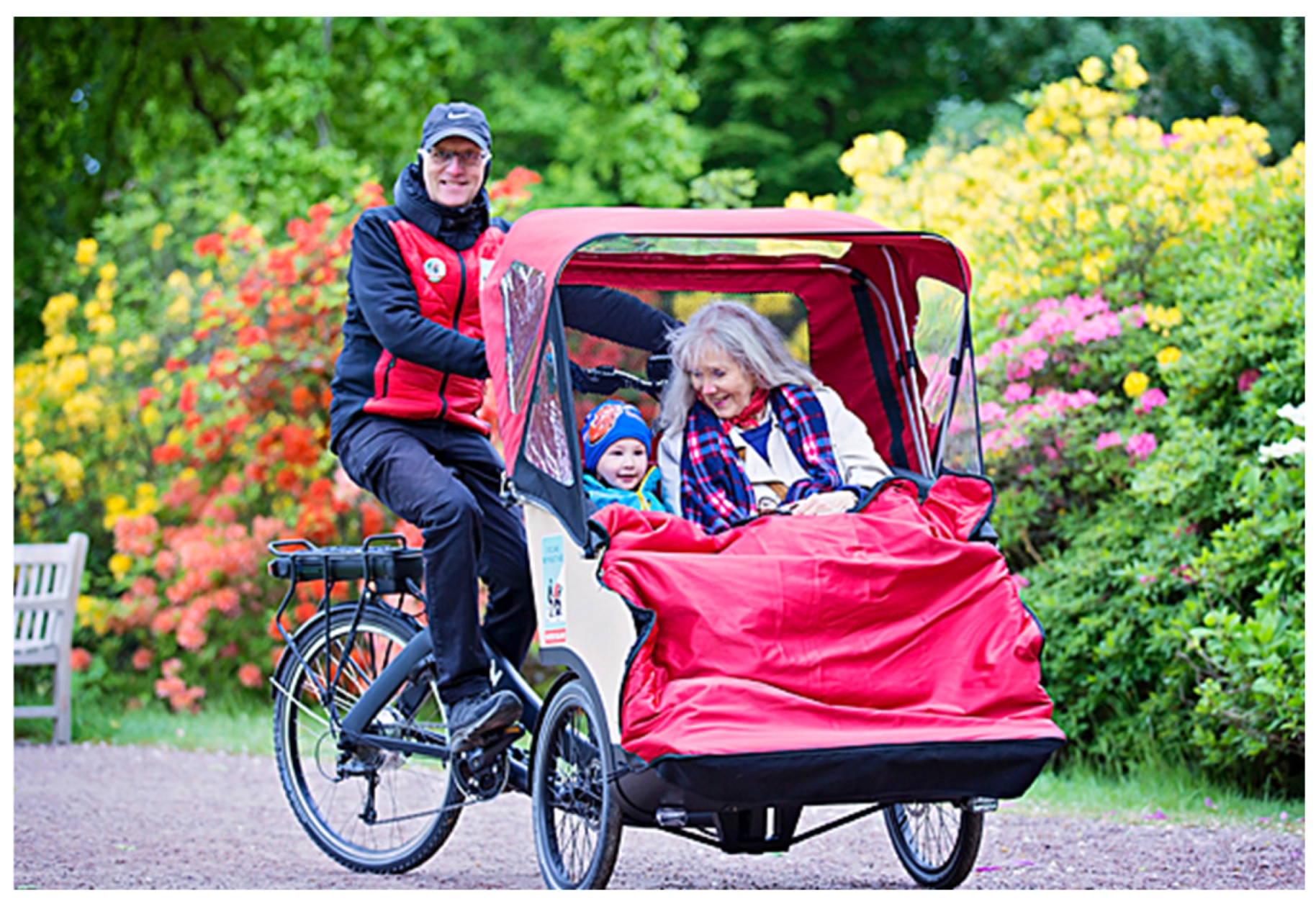
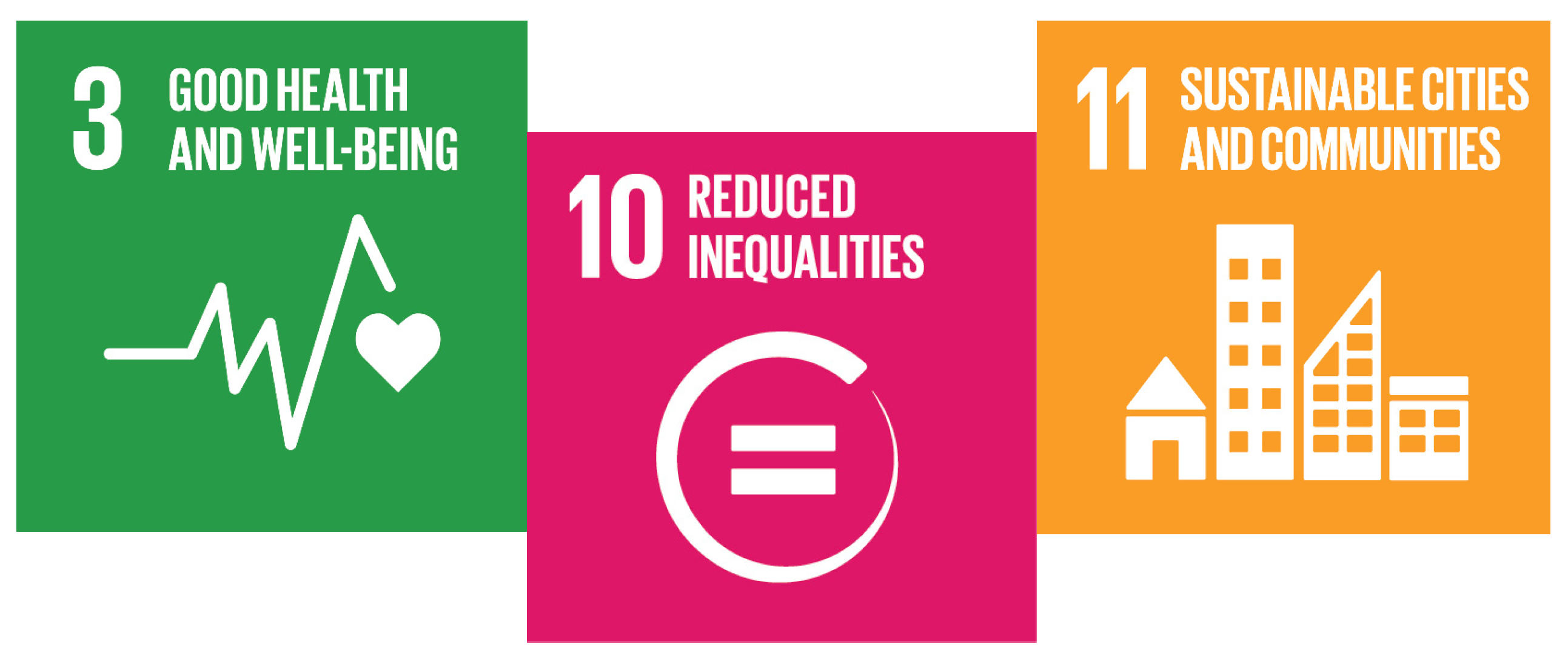
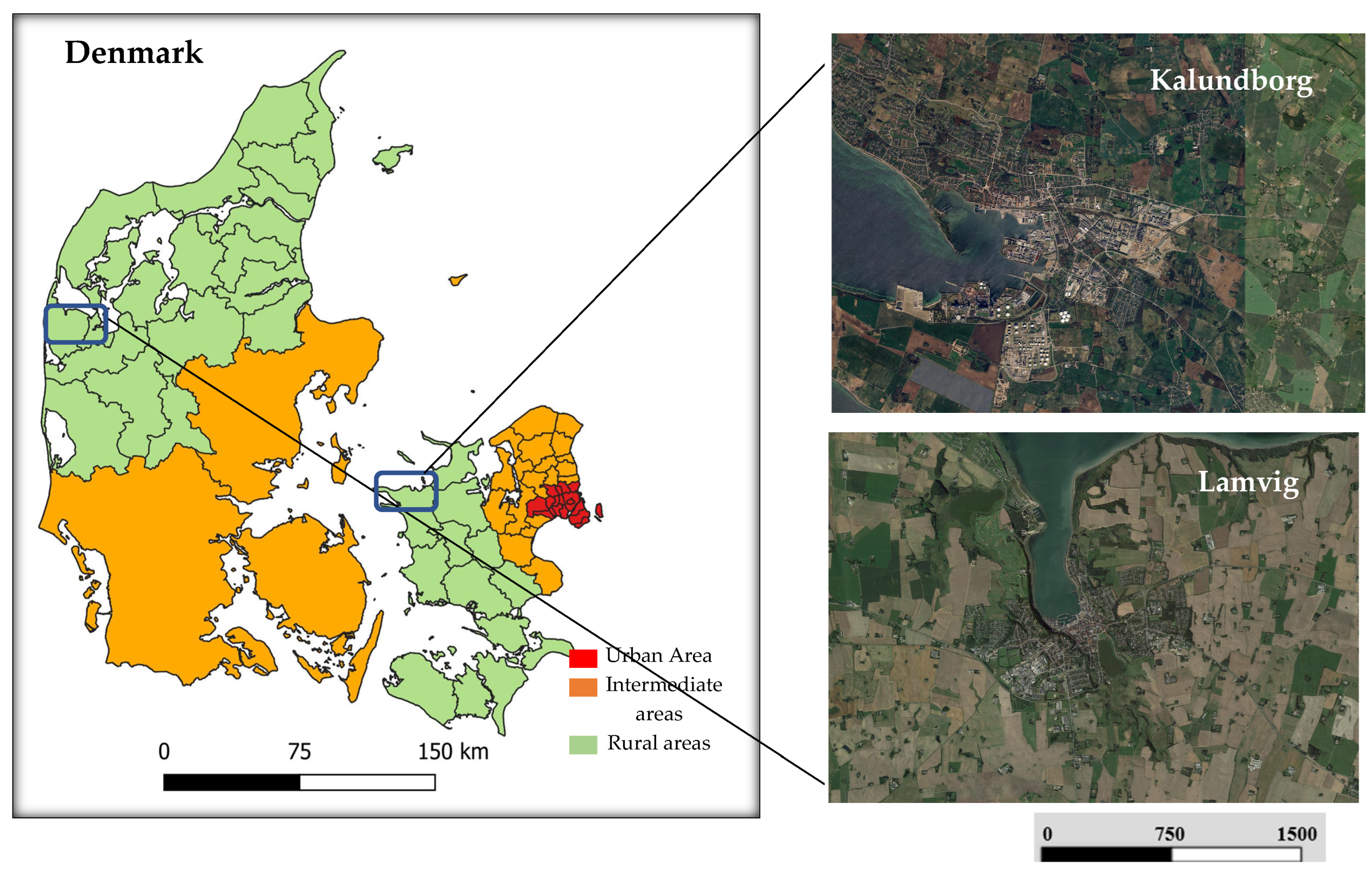
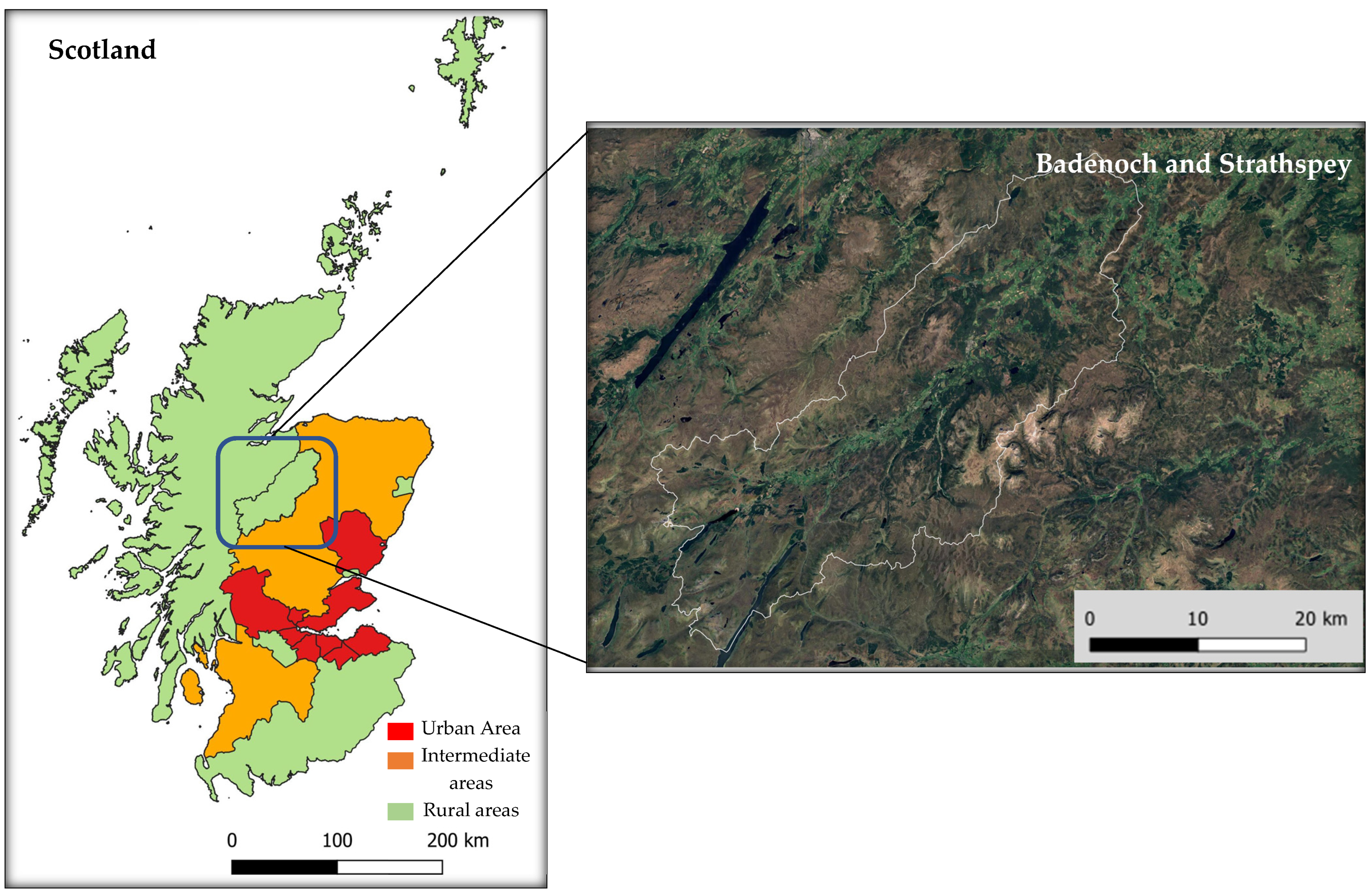
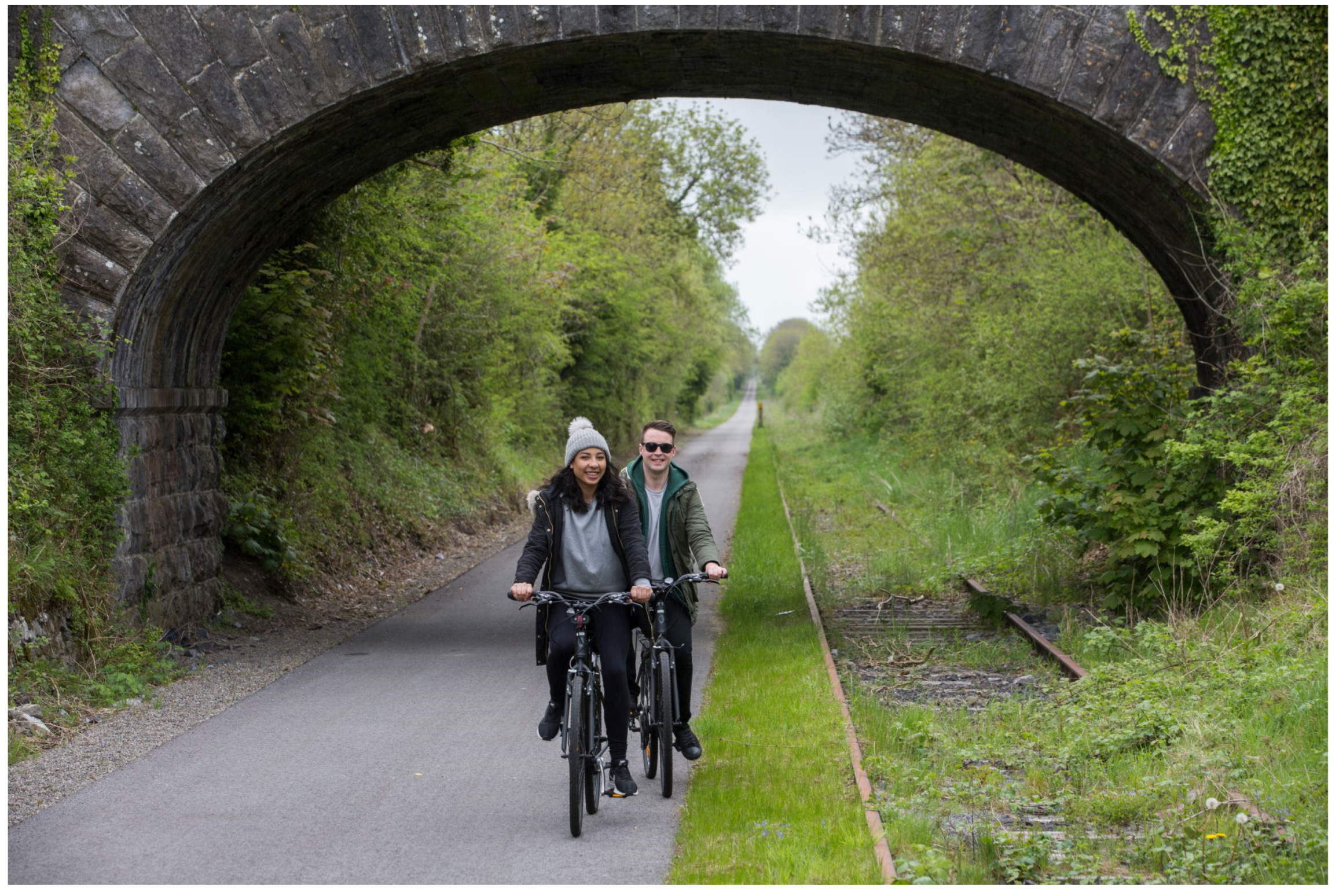
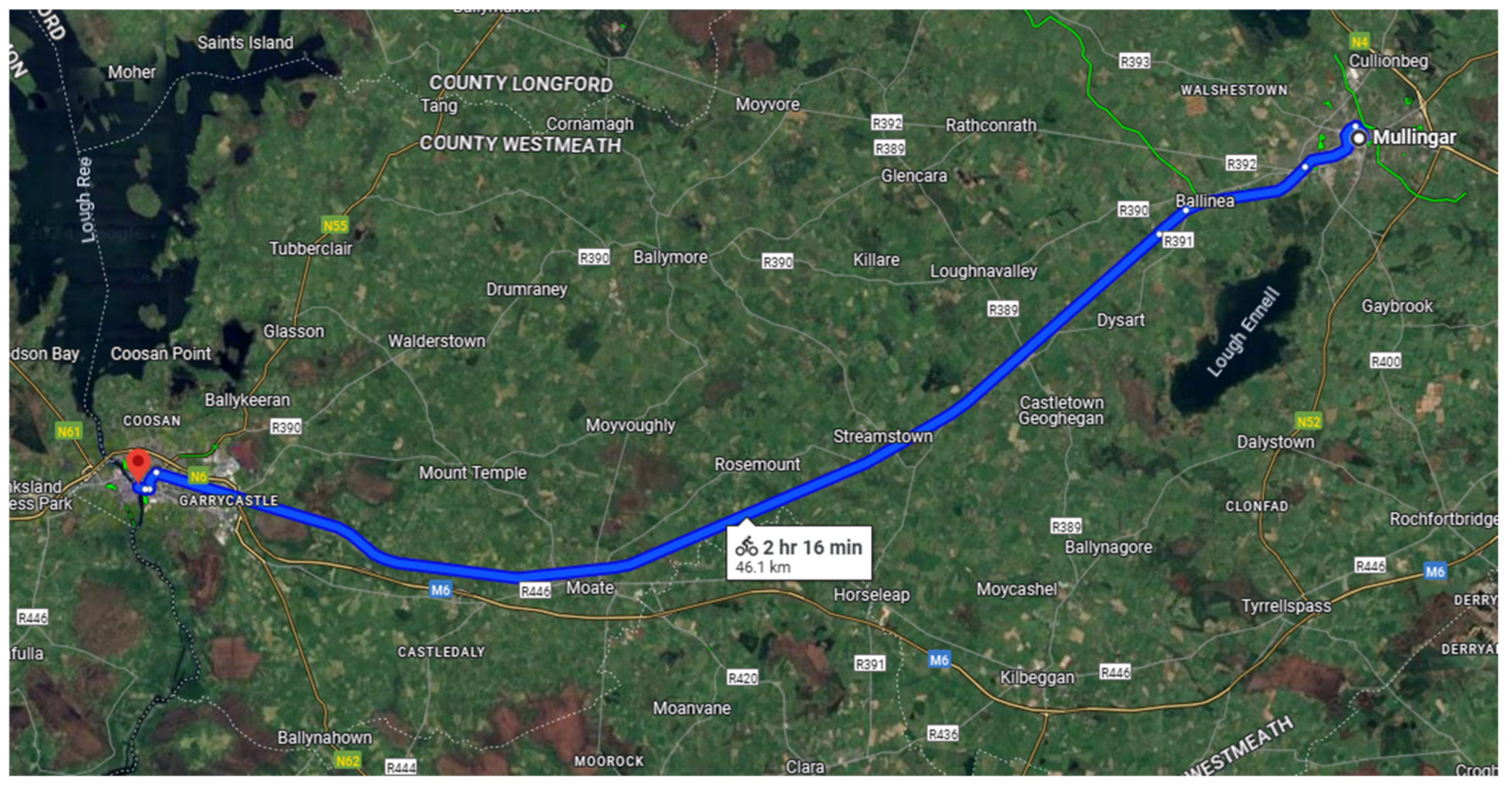
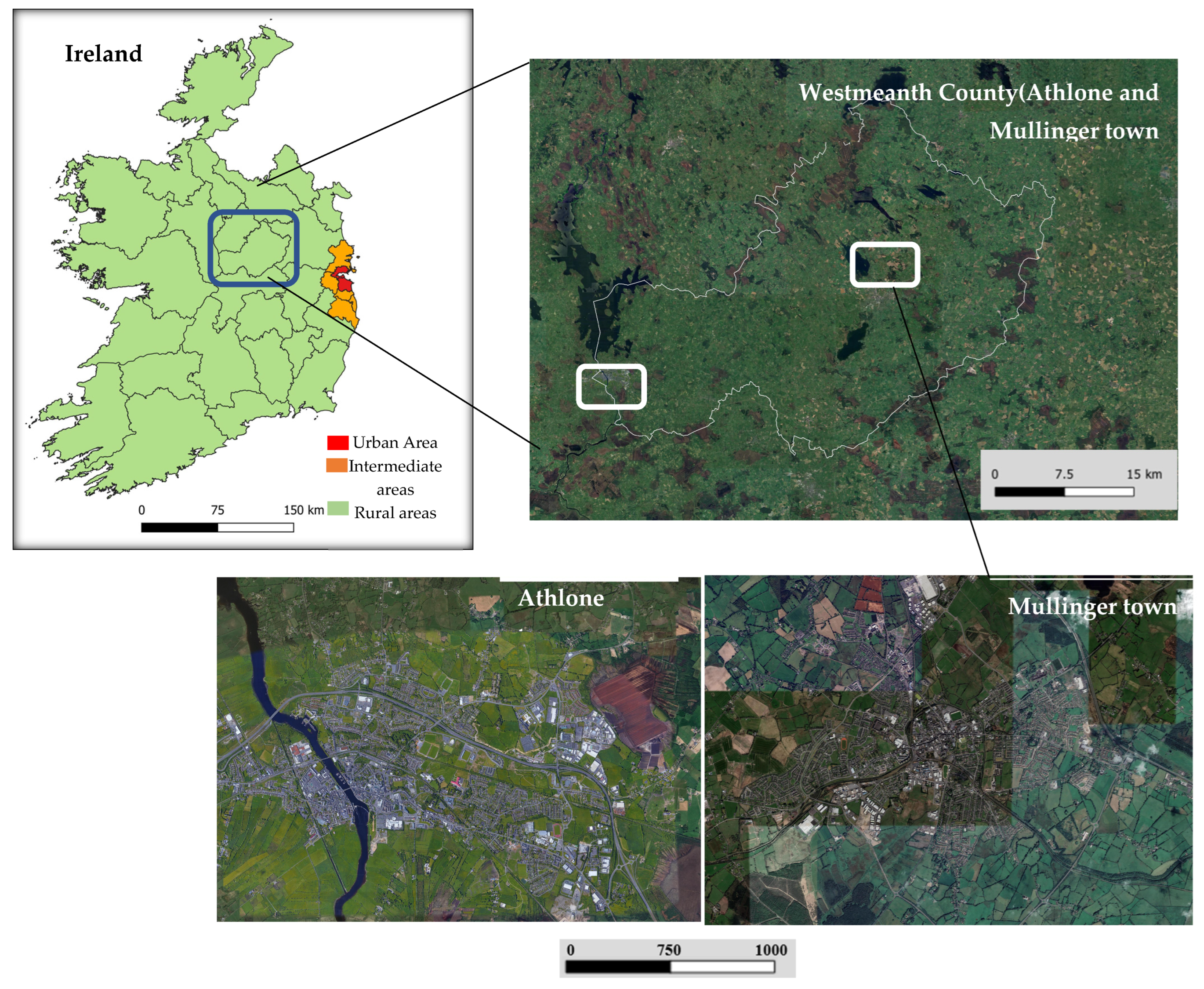
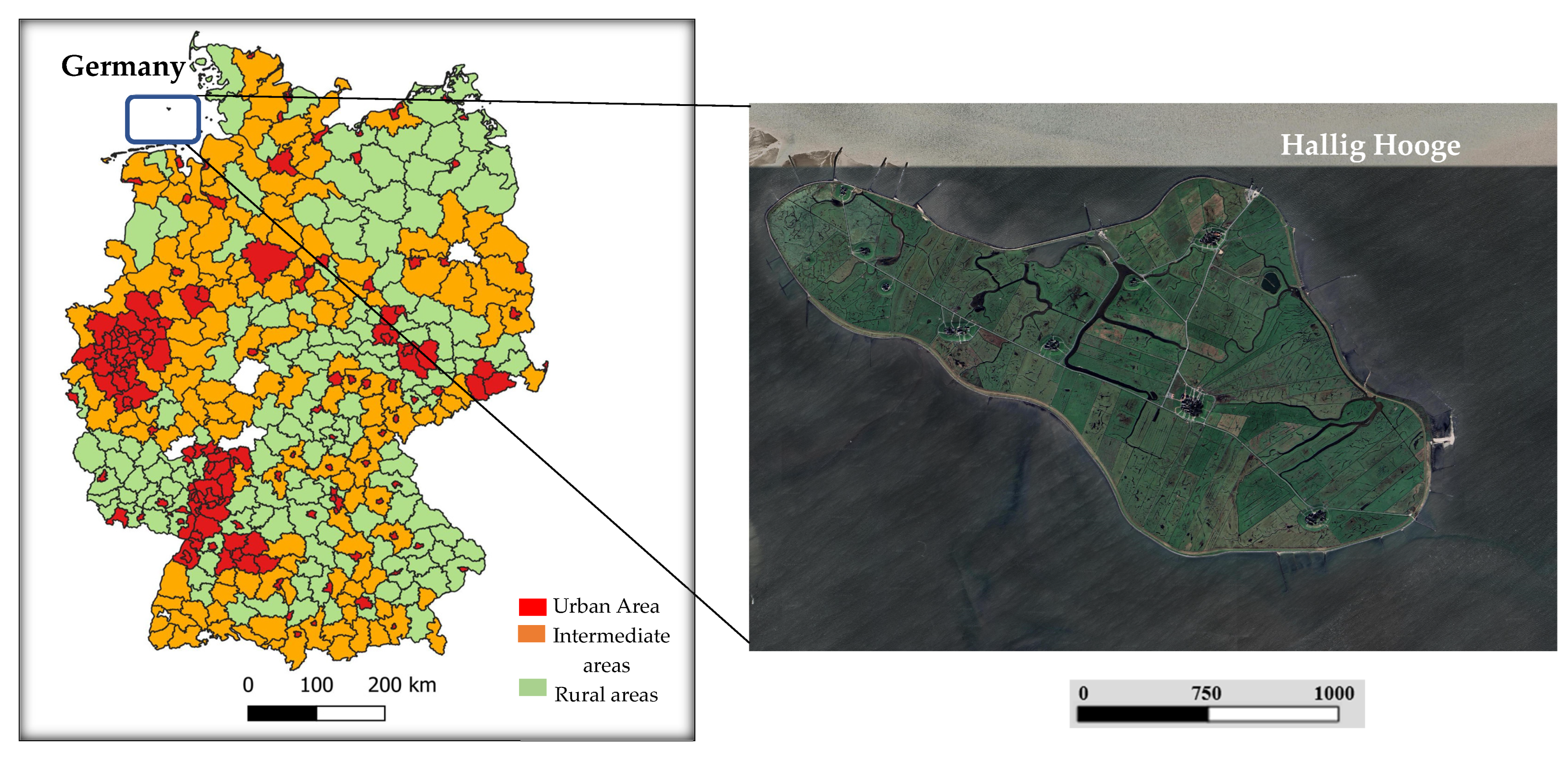
| Categories | Name of Good Practices | Engagement and Partnership | Social Inclusivity |
|---|---|---|---|
| Mobility Modes |
| Volunteer drivers + worldwide expansion The services is driven by volunteer engagement, empowering communities worldwide to participate in offering free trishaw rides to the elderly. | Fostering elderly engagement Enabling elderly participation fosters community bonds, reduces isolation, and enhances their connection to nature, improving overall well-being. |
| Community-driven This service was started by the UK charity Community Transport Association (CTA) to assist local groups in providing necessary transport, with an emphasis on enhancing accessibility for all. | Designed for disabled people The program provides accessible transportation for the elderly and disabled, with cars equipped with lifts or ramps and door-to-door assistance from drivers who are trained to meet the needs of their customers. | |
| Mobility Infrastructure |
| Heritage structures engaging community. The Old Rail Trail features intact stone arch bridges and ancient railway stations like Moate and Castletown, transforming these heritage sites into cultural and educational destinations for tourists. | Accessible for all This program provides pathways that are accessible to individuals of all ages and abilities. With its flat, well-kept paths, the Old Rail Trail welcomes families and cyclists of all abilities and provides a friendly atmosphere for everyone. |
| Mobility Platforms |
| Community involvement Through effective management Regular interaction with the community helped to create the solution and guarantee that the services met their demands. To map out priorities and promote cooperative project development with the islanders, a “solution tree” was employed. | Service-to-People Accessibility This program brings essential social services directly to the isolated island. It empowers residents, especially the elderly, with localized support through in-person meetings and telemedicine |
| Aspect | Cycling Without Age | Badenoch and Strathspey Community Transport | Westmeath Old Rail Trail | Hallig Hooge Service to People Accessibility Solution |
|---|---|---|---|---|
| Target groups | Elderly with limited mobility | Elderly, disabled, isolated rural residents | General public, elderly, tourists | Elderly, isolated island residents |
| Community engagement | Volunteer-driven; promotes intergenerational bonding | Volunteer drivers; participatory community planning | Community involvement through heritage and culture | Participatory planning with locals |
| Inclusivity focus | Social inclusion through interaction | Accessibility and economic inclusion | Physical and social inclusion via accessible infrastructure | Service delivery for inclusivity and independence |
| Geographic context | Denmark: Coastal, compact, industrial (Kalundborg); remote (Lemvig) | Rural Scotland: low population density, harsh weather | Ireland: urban–rural mix; flat terrain | Remote island: limited mainland access |
| Environmental factors | Emphasis on eco-friendly transport (trishaw rides) | Adaptation to harsh weather (door-to-door transport) | Reuse of old infrastructure for sustainable mobility | Minimal travel; sustainability through reduced travel |
| Economic impact | Free service; fosters community relationships | Section 22 permits for non-profit service | Boosts local tourism and economy | Reduces costs by providing on-site services |
| Key features | Trishaw rides promoting social interaction | Demand-responsive, wheelchair-accessible services | Greenway for biking/walking, connecting towns | Mobile counseling, elder care, telemedicine |
| Sustainability approach | Volunteer-based, low carbon footprint | Volunteer-driven, adaptable to extreme weather | Repurposing infrastructure, promoting active travel | Service delivery reducing travel needs |
| Strengths | Intergenerational bonding; replicable globally | Addressing geographic isolation effectively | Integration of tourism and mobility | Accessibility without travel |
| Challenges | Requires ongoing volunteer support | Volunteer recruitment and harsh weather management | Maintenance of greenway infrastructure | Maintaining consistent service delivery |
Disclaimer/Publisher’s Note: The statements, opinions and data contained in all publications are solely those of the individual author(s) and contributor(s) and not of MDPI and/or the editor(s). MDPI and/or the editor(s) disclaim responsibility for any injury to people or property resulting from any ideas, methods, instructions or products referred to in the content. |
© 2025 by the authors. Licensee MDPI, Basel, Switzerland. This article is an open access article distributed under the terms and conditions of the Creative Commons Attribution (CC BY) license (https://creativecommons.org/licenses/by/4.0/).
Share and Cite
Junaid, M.; Ferretti, M.; Marinelli, G. Innovation and Sustainable Solutions for Mobility in Rural Areas: A Comparative Analysis of Case Studies in Europe. Sustainability 2025, 17, 871. https://doi.org/10.3390/su17030871
Junaid M, Ferretti M, Marinelli G. Innovation and Sustainable Solutions for Mobility in Rural Areas: A Comparative Analysis of Case Studies in Europe. Sustainability. 2025; 17(3):871. https://doi.org/10.3390/su17030871
Chicago/Turabian StyleJunaid, Muhammad, Maddalena Ferretti, and Giovanni Marinelli. 2025. "Innovation and Sustainable Solutions for Mobility in Rural Areas: A Comparative Analysis of Case Studies in Europe" Sustainability 17, no. 3: 871. https://doi.org/10.3390/su17030871
APA StyleJunaid, M., Ferretti, M., & Marinelli, G. (2025). Innovation and Sustainable Solutions for Mobility in Rural Areas: A Comparative Analysis of Case Studies in Europe. Sustainability, 17(3), 871. https://doi.org/10.3390/su17030871





